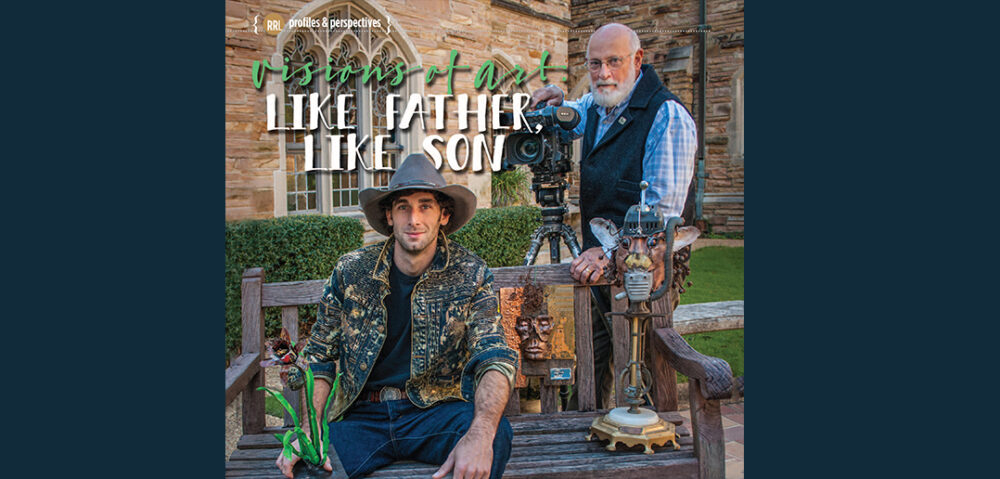If there is a limit to human expression the arts come probably as close to the edge as any. And among the edgier ones is photography pursued by Bill Schaum for more than 40 years and vision art sculpting by his son, Shipman.
SHIPMAN SCHAUM
He looks like a stand-in for a Renaissance painting — dark, rumpled hair and cheek bones perfectly chiselled, only lacking the plumed golden helmet to fit right into the heavily carved frame. But this Renaissance man is more than startling good looks for Shipman Schaum is multi-talented. He knows how to keep your truck engine running, how to make your computer be cooperative, and most of all, how to turn a piece of scrap metal into a work of sculptured art with his blow torch and hammers. “Even when I was little I always wanted to know how things worked, so I’d take them apart. Most of the time I’d get them back together.”
From the year he won an award at the age of 14 for a piece of sculpture, he’s been living the life of an artist creating extraordinary work often from tangled masses of junk.. “He’s a perfectionist,” his father says. “No matter how long it takes, the sculpture has to be perfect before his name goes on it.” Although the sculptor usually works with metal, he also has to include wood, bone and glass in listing his materials. Unfortunately, he does not accept Michaelangelo’s statement about sculpture that the figure you are carving waiting there in the stone and all you have to do is chip away the excess marble to release the person within. Usually, Shipman has to weld, forge, solder and hand paint his work to resemble natural or futuristic life.
Shipman is aware that many people are baffled by his attraction to sculpture because the tools and materials for creating it are so complicated and heavy. Brass and bronze, marble, stone, scrap metal — why not just pick up a brush and have at it with paint? “Maybe it’s the danger of it,” Shipman tries to explain. “I work with sharp tools all the time, and sometimes I’ve cut myself badly. My blood has actually soaked into the work. I guess I like the idea of being physically tied to the sculpture I’m working on as I keep trying to create what I have in my mind. And when somebody comes along and pays real money for it, that convinces me that I’m not as crazy as I sometimes think.”
There may also be another reason. Since most sculptors are men Shipman is probably right that sometimes a man’s testosterone just makes him want to grab a hammer and slam into something. And if that slamming “done just right turns into a beautiful piece of art, who can object?” To see his work… www.shipmansart.com, Instagram: Shipmansart, or by phone: 334.467.3074.
WILLIAM SHIPMAN SCHAUM JR.
Bill Schaum has been involved with video and still photography for more than forty years. Even so, as he says, “you never know it all. That’s what makes it so fascinating. Every day is another discovery.” His father was an amateur photographer and hooked Bill while he was still too little to resist. With the first pictures he was permanently mesmerized, an enchantment which has only grown with the years.
Throughout his career Bill has been fortunate to have shuffled off, not just this mortal coil, but the chains of Montgomery’s provincialism. Working steadily, he has wandered the world, exploring one remote venue after another. Camera at the ready, he has flown over the Great Wall of China in a Russian helicopter, walked in Tiananmin Square, watched the sunrise along the Amazon in Brazil, dined in the Great Hall in the Forbidden City, and interviewed big and little people in the Civil Rights Movement. Now he is working mainly in video, and is planning two documentaries. One, the in-depth story of the Blount Cultual Park, and the other, the history of Montgomery.
In the meantime, he is waiting for invitations to speak to high school and college classes about the ins and outs of photography. He loves to discuss his profession and now searches for the answer to a frequently asked question, what makes a great photograph? What is it about two iconic pictures, the one of Marilyn Monroe standing on the street grating with her skirt blowing up, and the other, the girl from Afghanistan with the startling green eyes which appeared on the cover of the National Geographic some months ago? “Well, of course it’s a matter of angle and especially of light, but more important than that, it’s what the viewer brings to the viewing. If it moves you emotionally, if it says something, anything, to you, then that photograph has meaning and depth to you. And every photographer knows that you never take the perfect picture. There’s always something you should — or should not — have done. So that’s why it’s so endlessly fascinating. You’re always searching for the next improvement.”






